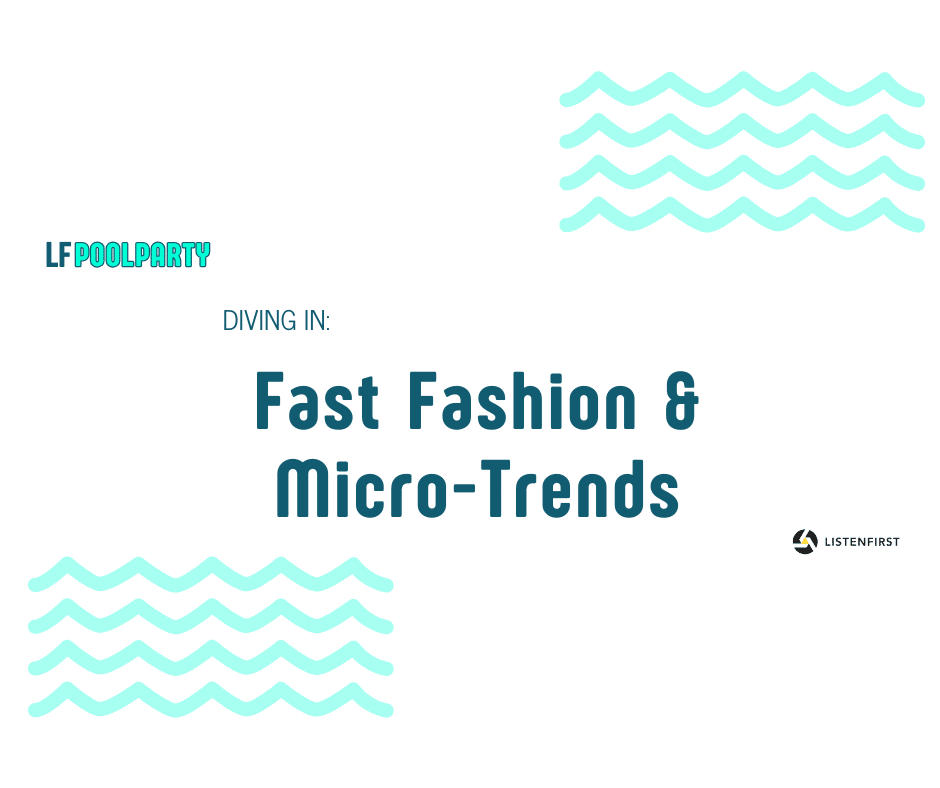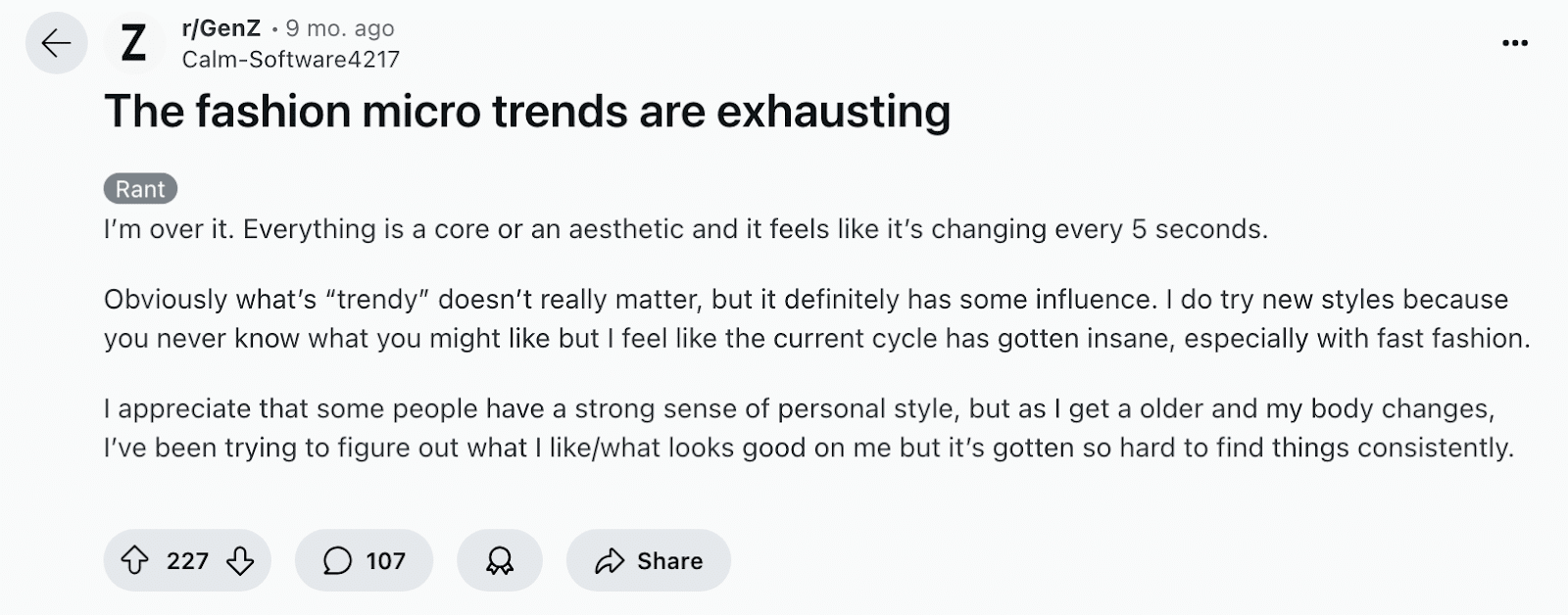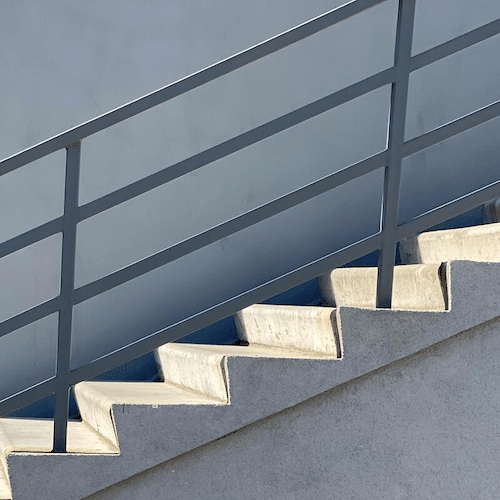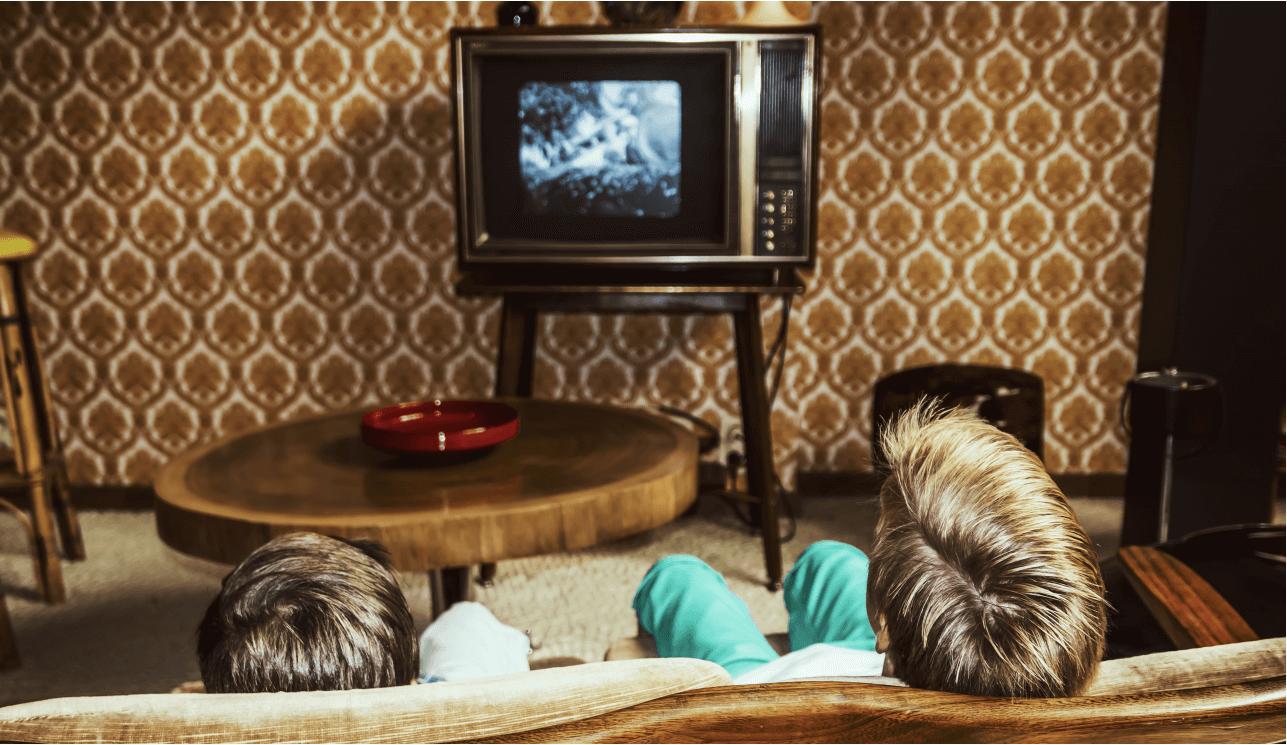
The Rise and Fall of the Micro-Trend
Fashion has always been cyclical, but with the rise of social media, that cycle has gone into overdrive with what seems like endless micro-trends. What used to take a decade to go in and out of style now barely lasts a month, thanks to TikTok’s ability to push aesthetics into the mainstream at lightning speed. Last summer alone, we saw a rapid succession of “cores”—Quiet Luxury, Tomato Girl, Barbiecore—each dominating our feeds before being replaced by the next viral aesthetic.
But as we move further into 2025, a shift is happening. The hottest trend right now? Not following trends at all.
As Vogue Business recently noted, fewer micro-trends are making their way from social media feeds to major fashion publications, and there’s an increasing emphasis on personal style over algorithmic dressing. Consumers—especially Gen Z—are growing wary of fast-moving aesthetics that make their wardrobes obsolete overnight. Instead, there’s a growing cultural movement toward dressing for real life, not for the feed.
Social Media’s Role in Micro-Trend Fatigue

Reddit users on r/GenZ discussing their annoyance with micro-trends
Micro-trends exist because of social media’s need for constant content. TikTok and Instagram reward novelty, pushing aesthetics like “Mob Wife” or “Office Siren” into the spotlight only to discard them weeks later. This has fueled an explosion in fast fashion, with platforms like Shein and Temu churning out thousands of new products daily to keep up with whatever TikTok has deemed stylish that week.
Yet, even fashion insiders are questioning whether this endless cycle is sustainable—or even enjoyable. As Katie Irving, Founder of Moonshot, a Fashion Concept & Product Innovation Studio, notes, “As trend-driven content accelerates, consumers are craving more depth—moving beyond fast aesthetics toward personal style. The smartest brands are embracing this shift, prioritizing substance and personal style over speed.” Trend forecaster Agus Panzoni agrees, speaking to Vogue Business about how we’re shifting away from the need to define every style under a hyper-specific label. Instead of adopting entire aesthetics wholesale, people are now cherry-picking elements that actually suit their lives. This pushback against micro-trends signals a rejection of dressing for an algorithm and a return to dressing for oneself.
Further, Panzoni argues that what we call “micro-trends” are actually just internet aesthetics—pre-packaged styles that consumers can quickly buy into but don’t have true longevity. These trends aren’t evolving organically over multiple seasons like traditional trends; rather, they are created and amplified by social media algorithms that cycle through aesthetics at an unsustainable pace.
From Trends to Vibes: The Shift in Fashion’s Identity
Rather than hyper-specific aesthetics, fashion is increasingly about a “vibe”—a broader, more immersive lifestyle. The concept was largely catalyzed by Brat Summer, which wasn’t just a look but an ethos, encompassing music, attitude, and cultural references. Unlike past micro-trends, vibes don’t require adherence to specific pieces; they embody a lifestyle that can be uniquely interpreted by each individual.
Fashion journalist Ashantéa Austin describes the shift: “A vibe communicates without direct signaling, whereas a trend often relies on explicit markers. Trends are mainstream and product-driven; vibes are niche, personal, and culturally expressive.” This movement marks a departure from fleeting aesthetics dictated by algorithms toward deeper, more meaningful fashion choices.
Katie Irving expands on this, stating, “Fashion is shifting from rigid aesthetics to fluid self-expression. The rise of ‘vibes’ over trends marks a return to individuality and longevity—and a rejection of algorithm-driven sameness.”
From a broader cultural viewpoint, Irving adds, “We’re entering an era defined by Maximalism and Bold Self-Expression—both a reaction to uncertainty and a rebellion against the algorithm-driven sameness that has shaped fashion’s recent past.”. Trends are mainstream and product-driven; vibes are niche, personal, and culturally expressive.” This movement marks a departure from fleeting aesthetics dictated by algorithms toward deeper, more meaningful fashion choices.
The rise of vibes also correlates with a rejection of hyper-consumerism. As TikTok-fueled trends like “mob wife” were exposed as marketing ploys, consumers grew more skeptical of purchasing a lifestyle rather than living one. Personal style is emerging as a counter-response to trend fatigue, leading to what many call the “vibe economy.”
IRL as the New Status Symbol
The biggest indicator of fashion’s shift away from hyper-online aesthetics? The resurgence of real-world experiences as the ultimate flex.
Post-pandemic, social currency is no longer about perfectly curated outfits or keeping up with the latest aesthetic—it’s about what you’re doing in those clothes. Studies show that 74% of Gen Z prioritizes IRL experiences over digital ones, which explains why brands are pivoting toward immersive activations and community-driven events rather than just pushing trends online.
Luxury brands have already caught on. From Sporty & Rich’s wellness retreats to Saint Laurent opening cultural hubs, fashion is moving away from fast-moving aesthetics and toward world-building. The future of style is experiential, not trend-based—a sharp contrast to the rapid micro-trend churn we saw in the early 2020s.
The Retail vs. Luxury Fashion Growth Divide
A deeper look at digital growth trends shows that retail and fast fashion brands are outpacing luxury brands in social media follower growth.
- Retail fashion brands gained over 43.7 million new followers in the past year, compared to 27.1 million for luxury brands.
- TikTok played a massive role, with retail brands gaining 14.5 million new followers compared to 8.7 million for luxury fashion.
- Instagram was also stronger for retail, with 21.8 million new followers versus 14.3 million for luxury.
This shift suggests that affordability, accessibility, and trend-driven content are fueling retail’s dominance, particularly on TikTok, where the algorithm favors fast-moving, viral aesthetics. Meanwhile, luxury brands—despite their cultural prestige—are struggling to capture the same level of rapid audience expansion. This further reinforces the idea that hyper-online fashion cycles are being driven by fast fashion, while luxury is moving toward longer-lasting, experience-driven branding.
Fast Fashion & Luxury Engagement Rankings
Fast fashion brands dominate online engagement, reinforcing the idea that social media fuels their success. Below are the top 10 most engaged fast fashion brands in 2024, ranked by Owned Social Score:
| Rank | Brand | Engagements | Owned Social Score |
| 1 | Pretty Little Thing | 65,265,409 | 66,001,659 |
| 2 | Shein | 59,116,620 | 64,314,922 |
| 3 | Fashion Nova | 62,713,233 | 63,732,971 |
| 4 | Zara | 22,618,035 | 25,990,007 |
| 5 | Temu | 8,894,697 | 17,878,896 |
| 6 | Hollister | 15,526,782 | 15,891,770 |
| 7 | H&M (Global) | 7,658,522 | 8,237,794 |
| 8 | Boohoo – Global | 7,174,559 | 6,821,748 |
| 9 | Princess Polly | 6,208,279 | 6,399,601 |
| 10 | Asos | 4,860,396 | 5,969,094 |
Below are the top 10 most engaged luxury fashion brands in 2024, ranked by Owned Social Score:
| Rank | Brand | Engagements | Owned Social Score |
| 1 | Dior | 92,879,800 | 96,317,725 |
| 2 | Calvin Klein | 70,676,983 | 72,273,811 |
| 3 | Gucci | 69,141,026 | 71,088,517 |
| 4 | Victoria Beckham Clothing | 65,558,162 | 67,436,869 |
| 5 | Loewe | 38,195,380 | 39,805,747 |
| 6 | Prada | 36,559,981 | 37,819,685 |
| 7 | Versace | 35,194,784 | 35,545,412 |
| 8 | Jacquemus | 30,306,429 | 30,986,502 |
| 9 | Skims | 29,593,895 | 30,693,960 |
| 10 | Chanel | 29,412,359 | 30,397,277 |
This data further proves that fast fashion continues to dominate digital spaces, but luxury brands are proving their staying power in engagement and influence. In fact, more luxury brands than fast fashion brands ranked higher in engagement, with six of the top ten most engaged brands overall belonging to the luxury sector. Additionally, all ten of the top luxury brands outperformed their fast fashion counterparts in Owned Social Score, signaling stronger long-term brand equity and deeper audience connections., leveraging social media to maintain high engagement and visibility. However, luxury fashion brands are still thriving in engagement metrics, with Dior, Calvin Klein, and Gucci leading the pack.
As the industry moves forward, luxury is increasingly prioritizing experiential branding and long-term identity over trend cycles, while fast fashion continues to drive high-volume interactions. With the growing cultural shift toward sustainability, personal style, and authenticity, the real question is: will fast fashion’s dominance in digital engagement translate into long-term consumer loyalty, or will luxury’s experiential strategies prove to be more enduring?
The Future: A Return to Personal Style
Rather than following every fleeting aesthetic, more consumers are embracing longevity and individuality in their wardrobes. The vibe economy means fashion is now about mood and identity rather than products alone. As the industry moves forward, brands must navigate a balance between authenticity, personal connection, and cultural relevance—because, in 2025, it’s no longer about buying into a trend. It’s about living a style.
Want more deep dives like this? Make sure to subscribe to our weekly newsletter, LF Pool Party, for everything social media professionals need to know to make their strategy a 10/10.


